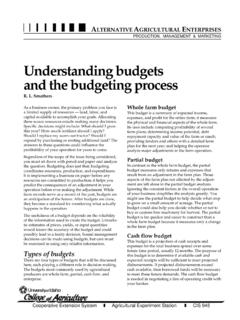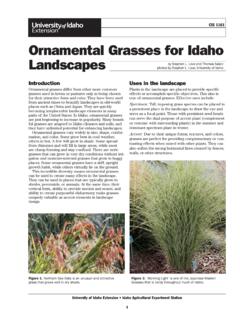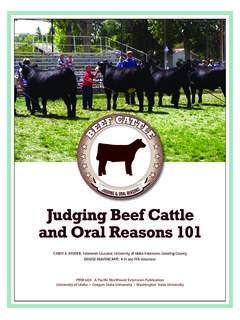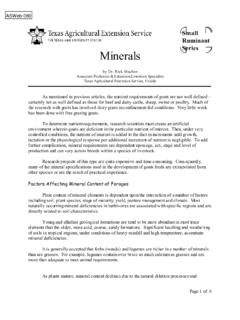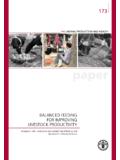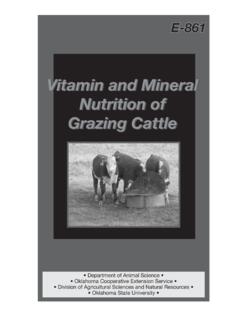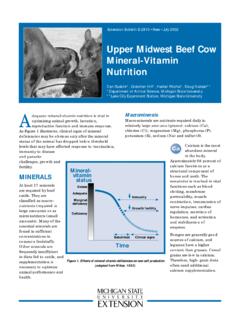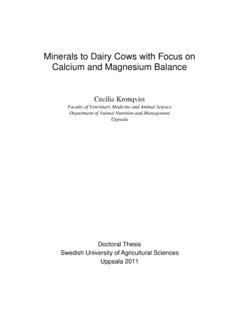Transcription of Mineral Supplementation of Beef Cattle in the Pacific ...
1 PNW 670 Mineral Supplementation of beef Cattle in the Pacific NorthwestBilly WhitehurstIntroductionMineral Supplementation programs are a point of confusion for many ranchers. Sales representatives, university researchers, and Cattle buyers bark at ranchers about how important it is to keep their Cattle on a Mineral program. Ranchers, however, are often at a loss as to how to assess Mineral deficiencies, which Mineral packages they need to purchase, whether they should have a custom Mineral mix prepared, how much to feed, what type to feed, and whether it is even profitable to supplement the flood of information that ranchers receive on the topic, often from sources that are trying to sell a product, it is easy to understand the confusion. This bulletin takes a basic, common-sense approach to assessing Mineral needs for beef Cattle and beginning the thought process to determine where producers should invest money on Mineral programs and where they could save a few dollars without diminishing requirements for Cattle vary with life stage, phase of production, stress factors, and more.
2 The Mineral status of soils and forages can vary greatly over a geographic region as well. Therefore, this bulletin does not address specific Mineral requirements, but rather serves as an overview to help producers better understand the importance of Mineral Supplementation as it relates to optimizing production. Producers should consult with their Extension professional or nutrition -ist to assess what dietary minerals they need to provide to their Cattle given their specific in mind that it is often hard to measure the effectiveness of a Mineral program in terms of dollars made, because the Mineral program is only one part of a bigger picture. We do know that when Cattle become deficient in minerals, sickness increases and perfor-mance declines. Most Mineral programs cost $25 to $35 per cow annually (based on 2014 prices) and can be viewed as a relatively inexpensive insurance policy to help protect against disease and financial losses due to poor OverviewThe minerals in supplements fall into two categories: macro and micro.
3 Macro minerals are the minerals needed in larger quantities in the diet. They are typi-cally represented as a percentage of the diet in a feed or Mineral analysis. Macro minerals are not stored well in the body and therefore require a more constant supply. They are typically more available in the Cattle s diet than micro minerals, and pass through the milk to nursing minerals are those needed in trace amounts and generally are in shorter supply within the base diet. Only small amounts of micro minerals pass through milk to nursing calves, making calves reliant on the stores they have in their liver at birth until they begin to ingest forage and supplements as they grow. Calf liver stores at birth largely depend on liver concentrations in the dam. Trace minerals are usually represented in a feed analysis with a ppm (parts per million) unit deno-tation (table 1).
4 Because micro minerals can be stored in the liver, constant intake is not Pacific Northwest Extension PublicationUniversity of Idaho Oregon State University Washington State UniversityContentsIntroduction ..1 Mineral Overview ..1 Macro Minerals and Symptoms of Deficiency or Toxicity ..3 Micro Minerals and Symptoms of Deficiency or Toxicity ..5 Organic vs. Inorganic Minerals ..7 Supplementation Frequency, Final Advice ..8 References ..92 Determining deficiencyCattle producers should be aware of two types of Mineral deficiency. The first is a clinical deficiency, where a diagnosis can be made by a visual appraisal of an animal showing clear signs related to a specific Mineral deficiency. The second and most common is a subclinical deficiency. At this stage of deficiency, signs and symptoms are not well defined or visible/obvious.
5 The animal may not be performing to peak potential but appears to be in good health, making the producer think all is well. For this reason, Cattle with subclinical deficiencies often remain can be determined through analysis of blood, urine, feces, and liver biopsies, depending on the Mineral . While it would be ideal to periodically per-form blood tests and liver biopsies of a representative portion of a herd to ensure proper Mineral levels, many producers do not have the facilities, time, or resources to perform such tests. Soil analyses can be helpful in determining the diet s Mineral status, as minerals in the soil may be (but are not always) indicative of Mineral levels in the forage it most common way to assess Mineral deficiencies at the ranch level is through feed analysis, which offers producers a reasonably priced way to assess what nutrients their animals are ingesting and thus get a reasonable estimate of possible Mineral deficiencies and/or interactions.
6 Keep in mind that every haystack and pasture can have different Mineral levels. Season and life stage of the forage also affect Mineral content, so ideally producers would do a forage analysis for each field, pasture, and season on a ranch. While we don t live in an ideal world, producers should take what measures they can to reasonably assess their Mineral situation and move forward from there. A reasonable effort is better than no minerals are referred to as antagonists. These minerals bind other minerals, making them unavailable to the body. If an antagonist is binding an essential Mineral , it can create a deficiency for the cow. When antagonists are present, producers must feed more of the bound Mineral to compensate for the antagonistic interaction, as it is generally unrealistic and impractical to remove the antagonist from the sources are often the origin of antagonists, particularly iron and sulfates.
7 Water quality tests can be critical in determining the level of antagonism present in a diet. Soils and forages can also harbor antagonists, so forage quality should be analyzed as well. Examples and strategies for compensating for antagonists will be discussed later in this interactionsWhen developing Mineral Supplementation programs for Cattle , it is not always possible to identify one min-eral that is deficient and supplement for that Mineral alone. Minerals interact with each other, such as the antagonist interactions just described. They can also have synergistic reactions that complement each other or have indirect interactions. Figure 1 illustrates the comprehensive approach need-ed to analyze or develop a Mineral Supplementation program. Even a cursory look at this interaction wheel reveals that Mineral nutrition is a complex 1.
8 Example partial guaranteed feed analysis. This shows the type of nutrition information found on a Mineral supplement. Macro minerals are expressed as a percentage of diet, while micro minerals are expressed in parts per million (ppm). Mineral Value UnitMacro minerals Calcium not less than % Calcium not more than % Phosphorus not less than % Salt not less than % Salt not more than % Potassium not less than % Magnesium not less than %Micro minerals Cobalt not less than 35 ppm Copper not less than 3,500 ppm Iodine not less than 370 ppm Manganese not less than 5,800 ppm Selenium not less than ppm Zinc not less than 7,000 ppmFigure 1. Mineral interactions. Lines on the wheel indicate an in-teraction between minerals. Adapted from Underwood, E.
9 J. - PhosphorusCr - ChromiumCo - CobaltPb - LeadFe - IronSe - SeleniumNa - SodiumCa - CalciumAg - SilverCd - CadmiumHg - MercuryAl - AluminumCu - CopperMn - ManganeseK - PotasiumMo - MolybdenumI - IodineMg - MagnesiumZn - ZincSi - SilicaAs - ArsenicF - FluorineS - Sulfur3 Macro Minerals and Symptoms of Deficiency or ToxicityCalciumCalcium is a macro Mineral needed in the diet for bone structure, milk production, and a host of other biological functions. Calcium is prevalent in good-qual-ity forage and a deficiency is generally not a major concern in beef Cattle herds. Most Mineral packages have adequate calcium to ensure that deficiency is not a problem. Toxicity is rarely a concern because Cattle can excrete excess reacts with phosphorus and the two minerals are best utilized when they are present in a Ca:P ratio between 1:1 and 3:1.
10 Urinary calculi can lead to water belly in Cattle when the Ca:P ratio falls below 1:5; however, this is more prevalent in concentrate diets typically used in a feedlot setting. While Ca:P ratios of up to 7:1 have occurred for short periods of time with no ill effects, allowing a ratio greater than 7:1 for an extended period can bind up phosphorus and make it unavailable to the deficiencies are common and generally re-sult in less-than-desired performance in the areas of re-production, milk production, and growth of calves. Not surprisingly, two signs that producers observe when phosphorus is deficient are decreased appetite and loss of cycling activity in breeding females. Phosphorus is rarely present in levels that could be toxic, and phos-phorus requirements rise with an increase in produc-tion demands. As noted above, the calcium-to-phospho-rus ratio should stay between 1:1 and 3 is a macro Mineral for which deficiency is most notably associated with the disease grass teta-ny.
